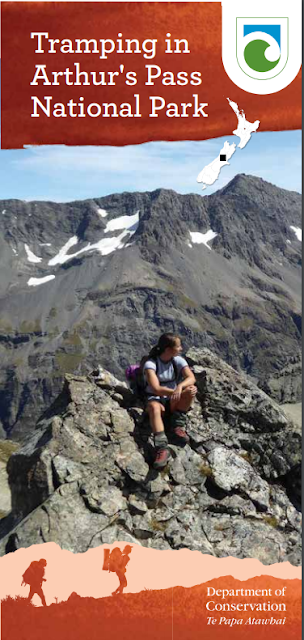The Department of Conservation have a very informative brochure about tramping in Arthur's Pass, it is titled Tramping in Arthur's Pass. The following information is taken straight from the DOC website but I have included it here as it is highly relevant to anyone planning a trip to Arthur's Pass National Park:
 |
| DOC brochure: Tramping in Arthur's Pass NP |
Tramping in Arthur's Pass
Arthur’s Pass National Park is rugged and mountainous; its back country tracks and facilities are not as developed as most other national parks in New Zealand. There are limited options for people with little or no tramping experience as most trips require route-finding and river-crossing skills.
Trips for trampers with moderate experience
- 3–6 hours each day
- Suitable for people with low–moderate tramping experience
- Basic route-finding skills needed
- Some tramps require river-crossing
| Route | Above bushline | River crossing | Route finding | Avalanche risk |
|---|---|---|---|---|
| Carrington Hut | No | Yes | Yes | No |
| Cass-Lagoon Saddle Track | No | Yes - side streams | No | Yes |
| Hawdon Hut | No | Yes | Yes | No |
| Casey Saddle - Binser Saddle Route | No | Yes | Yes | No |
| Edwards Hut | No | Yes | Yes | No |
| Carroll Hut | Yes | No | No | Yes |
Trips for trampers with moderate-high experience
- 5–8 hours each day
- Suitable for well-equipped people with previous back country experience
- Map-reading and route-finding skills essential
- River crossing skills essential
| Route | Above bushline | River crossing | Route finding | Avalanche risk |
|---|---|---|---|---|
| Avalanche Peak Route | Yes | No | Yes | Yes |
| Avalanche Peak to Crow Hut Route | Yes | Yes | Yes | Yes |
| Harper Pass Route | Yes | Yes | Yes | No |
| Mingha-Deception Route | Yes | Yes | Yes | Yes |
Trips for highly experienced trampers only
- 7–10 hours each day
- Suitable for well-equipped and experienced back country trampers only
- Often difficult country – may involve rock scrambling
- Many unmarked routes – map-reading and route-finding skills essential
- River-crossing skills essential
| Route | Above the bush line | River crossing | Route finding | Avalanche risk |
|---|---|---|---|---|
| Three Passes Route | Yes | Yes | Yes | Yes |
| Edwards-Hawdon Route | Yes | Yes | Yes | Yes |
| Harman Pass Route | Yes | Yes | Yes | Yes |
| Minchin Pass Route | Yes | Yes | Yes | Yes |
| Edwards-Otehake Route | Yes | Yes | Yes | Yes |
Be aware of these factors
Weather in Arthur’s Pass National Park changes quickly
Sharp falls in temperature, heavy rain, and strong winds can occur any time of the year. Always be prepared to change your plans. In bad weather you risk exposure if above the bush line, and drowning if crossing flooded rivers.
Remember
- Get the latest weather forecast from the Arthur’s Pass Visitor Centre before setting out.
- Be prepared for the worst.
- Carry warm clothing and waterproofs.
- Do not go above the bush line in bad weather.
- Rivers rise very quickly during rain – even if it’s far away in the headwaters.
You must know where and how to cross rivers safely
Unlike the Great Walks and other easy tramps in New Zealand, many tracks and routes in Arthur’s Pass do not have bridges.
Rivers and major side streams rise rapidly after rain. Several trampers have drowned crossing swollen rivers.
Rivers and side streams tend to be higher in spring when snow is melting.
Remember
- Read the route guide and map carefully to see where the major crossings are. Before crossing assess the river’s speed, depth, colour, catchment area and run-out. Consider escape routes along your route.
- Know how to choose the best crossing places: don’t cross discoloured rivers, surging water, or major rapids; watch out for sounds of rolling stones in the riverbed, or trees and debris being carried along.
- Do not take risks. If a river is flooded, wait it out – better late than dead!
You need route-finding skills
Many of the routes in Arthur’s Pass require some route-finding skills. Tracks and routes are not always continuously marked – especially in wide riverbeds and above the bush line, where the landscape changes rapidly due to slips and floods. You will need to find the safest route.
Remember
- Always take a topographic map and compass with you.
- Do not rely on GPS – it will not work in the thick bush or confined spaces.
- If visibility is poor, do not go above the bush line unless you have good navigation skills.
- Write your tramping intentions in hut books as you pass through.
- If you are lost or injured: Stay where you are. Find or construct a shelter if possible. Leave signs of your presence and conserve energy.
Avalanches are a seasonal risk on many tracks
Some high-level tracks and routes in Arthur’s Pass are exposed to avalanches in winter and spring. Some passes have year-round snow and ice.
No comments:
Post a Comment